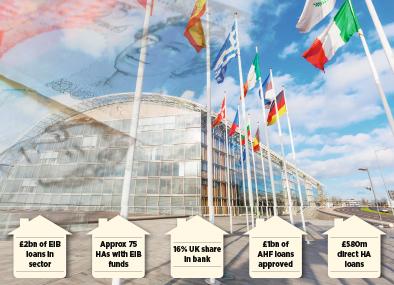Cost of funds falls but fewer HAs on cheapest rates
Housing associations’ average cost of funds fell slightly in the last financial year to 4.59 per cent.
Social Housing’s annual analysis of the average cost of debt at UK’s largest 130 associations at the 2014/15 year end found the rate was 5 basis points lower than the 4.64 per cent average of 2013/14.
However it was above the 4.54 per cent average cost in 2012/13.
Click on the PDF below for the full tables
During the period the Bank of England base rates also remained at a historic low of 0.5 per cent. The value of gilts also hit a low point during the year - so all in cost is lower - but spreads have risen generally.
The sector in England continued to source an increasing amount of debt from the capital markets, according to The Homes and Communities Agency’s Global Accounts for 2014/5.
Our analysis looks at the average price of debt for the largest associations using data from their 2014/15 accounts.
The housing associations included in this analysis own and manage more than 2.6m homes.
In total, associations paid £2.6bn of interest and had drawn loans of £56.4bn (see table, p.20).
Compared with a year earlier, the value of drawn loans rose by 8 per cent, total amount of interest paid grew by nearly 6 per cent while the number of units rose by 2 per cent. Debt per unit grew by £34 to a rounded figure of £970.
The biggest change came in the number of associations paying between 3.5 per cent to 3.99 per cent for their debt which fell from 26 associations to 17.
There was also a rise in the number paying 4.5 per cent to 4.99 per cent from 26 associations to 33 and a rise in those in the next bracket - 5 per cent to 5.49 per cent- from 14 to 21 organisations.
However, the table also reflects the decline of very cheap deals. The largest percentage fall in the number of units covered by an interest rate band came in the sub-3 per cent interest rate category, where the number of units fell by 64 per cent or 54,900 homes.
The number of units in the 3 to 3.99 per cent interest category only changed by single-figure percentages. The 4.5 to 5.49 brackets changed by 38 or 40 per cent.
Most homes are covered by loans with mid-ranking levels of interest.
The 4.5 to 4.99 category saw the largest increase in the number of homes covered, up by 207,011. But the number of homes in the 5.5 to 5.99 per cent interest group fell by 139,743 or 28 per cent.
Those in this year’s most expensive interest category - 6 to 6.49 per cent - grew by over 47 per cent or 16,530 properties.
Individual associations
The organisation with the highest cost of debt in this analysis was City West at 6.4 per cent, up from 5.31 per cent the previous year, which put it 23rd. However its interest payable and interest per unit were in the bottom half of the table.
It also had one of the biggest changes in its cost of funds, which rose 1.09 per cent.
Click on the PDF below for the full tables
It refinanced in 2012, breaking old fixed rate deals and replacing them with new fixes on £80m on a total of £10m of loan facilities. It aims to forward fix interest rates on as much of its debt as possible to reduce exposure to future increases.
City West was formed to take homes from Salford City Council in a stock transfer in October 2008.
Livin, which had one of the highest cost of funds in 2013/14 at 6.11per cent, was fourth in 2014/15 having reduced the cost to 6.03 per cent. It borrowed £7.8m during the year to finance its capital investment programme and repaid £3m of that.
In its accounts, Livin said the interest rates in its loans varied between 6.2 per cent and 6.61 per cent for fixed rate loans and 2.75 per cent for the revolving loan.
It said these were higher than the sector average because the stock transfer from Sedgefield District Council which formed the organisation took place in March 2009 when borrowing costs were high because of uncertainty in the financial markets. It had been looking at refinancing during 2014/15 but paused it in December 2014.
Sean Brodie, executive director of finance at Livin, said it had decided not to refinance then because market conditions would have meant significant costs to break Livin’s existing fixed rate loans. He added: ‘In the meantime Livin is continuing to assess its options.’
At the other end of the table, Plymouth Community Homes, Alliance, and Golden Gates remained the three organisations with the cheapest cost of funds.
Plymouth’s figure rose slightly from last year from 2.22 per cent to 2.58 per cent.
Alliance also saw a rise from 2.46 per cent to 2.73 per cent but Golden Gates enjoyed a 10 basis point fall between 2013/14 and 2014/15.
Plymouth Community Homes, a stock transfer from Plymouth council in 2008, drew £30m during the year under an agreement with The Housing Finance Corporation backed by the European Investment Bank in order to fund part of its North Prospect development. The organisation’s debt will peak in 2021. It has an interest rate hedge but decided to buy out the early years and move to floating rates because of current low interest, its accounts said.
Alliance has fixed rates on £30m of its loan book at rates between 2.76 and 4.8 per cent.
Golden Gates, which joined Torus Group with Helena Partnerships in April 2015 just after the year end, has a £70m loan facility with borrowing taken out initially on short-term variable rates currently of 1.99 per cent to 2.07 per cent with a series of forward fixes.
The fixes are higher than the rate currently available but lower than the long-term average of 7 per cent assumed at the time of transfer, according to Golden Gates’ accounts
The largest rise in cost of funds between 2013/14 and 2014/15 was at The Wrekin, where it increased from 3.43 per cent to 4.87 per cent.
The Wrekin’s accounts said its policy is to keep between 50 and 80 per cent of its borrowings at fixed rates, although at year end 86 per cent of its borrowing were fixed.
It said this percentage will fall as it makes further drawdowns on variable rate loans for its development programme in 2015/16. The amount of debt per unit rose in the year, but it said the board and regulator thought it was not at an unreasonably high level given the investment in stock it has made over the past 16 years.
Francis Best, director of finance at Wrekin Housing Trust, said: ‘The Wrekin Housing Trust refinanced its loans in May 2012 and, as part of that financing deal, put in place a long-term series of fixed rate swaps to hedge against future interest rate rises.
‘A number of these fixed rates kicked in during 2014/15, which accounts for the increase in cost of funds between the two periods. Of course, treasury management is never an exact science and there is usually a trade-off between cost of funds and obtaining the right balance of risk in the interest rate strategy.’
The biggest fall in the cost of debt was at Rochdale Boroughwide Housing, where the cost of funds fell from 6.54 to 5.31 per cent. In 2013/14 it had one of the highest cost of funds, whereas now it sits 22nd.
Red Kite, which had the highest cost of funds in the table published in 2013/14, does not feature in this table because it is no longer one of the largest 130 associations by units.
Banks and capital markets
2014/15 saw some banks enter or re-establish themselves in the housing association lending market, including the likes of HSBC and Clydesdale and Yorkshire Bank.
Click on the PDF below for the full tables
Gilt rates fell during the period leading to a fall in yields on housing association bonds during that time. But there was also a widening of spreads, partly as investors demanded higher margins to offset some of the fall in gilt yields.
Another major factor in the lower cost of funds was refinancing of old, expensive debt at lower rates.
Howard Webb, director at Capita Asset Services, said: ‘Every year a certain amount of historic high fixed interest rate [loans] roll off and are re-fixed at lower interest rates.’
He added that loans were now short rather than long-term and often libor-linked rather than containing fixes.
The Homes and Communities Agency’s Global Accounts for 2014/5 said there were 41 housing association bond issues or private placements in 2014/15.
As a result, the value of housing association bond issues or private placements made in the year went up by 25 per cent to £4.4bn having been at £3.3bn in 2013/14.
The increase in bond finance was likely to be behind a rise in cash and short-term investments by £500m to £5bn because bonds typically involve a large cash drawdown when they are issued. It also found the value of short-term loans rose 17.6 per cent to £816m to make up 1.3 per cent of all outstanding debt.
The Global Accounts said banks continued to offer loans to housing associations but the number and capacity of lenders is limited.
It also said the sector fixed the interest on about 69 per cent of its debt on average, up 2 percentage points from the previous year.
Beyond 2014/15
The trend of higher margins in the capital markets continued for much of the time after March 2015.
Between April 2015 and February 2016, almost all bonds issued during 2014/15 saw their margins rise by more than 40 basis points (see chart p.21, bottom right).
Click on the PDF below for the full tables
The period includes the July 2015 Budget which included a series of policies with major financial implications for housing associations, such as the annual one per cent rent cut over four years.
By February 2016 yields were generally higher than in April 2015, but within this period there was volatility with some months predominantly showing rises and others falls.
The movements were caused by a host of issues such as economic slowdown in China and falling oil prices, which had an impact on bond yields in a wide range of sectors.
Just two bonds - L&Q and Metropolitan -have been issued since April 2015.
Mr Webb said: ‘The most remarkable thing about the period was how little issuance there was. It has been very quiet given where gilt yields are. Not withstanding higher margins, housing associations could get very attractive long-term rates.
‘People have not been grabbing it, which suggests development programmes are being scaled back massively or moved into home ownership programmes which do not require long-term fixed funding.’
David Mairs, director at treasury advisers Murja, said: ‘There has not been anywhere near as much capital market activity in the last eight months or so.
‘This is mainly because there was a lot of activity before so people are sitting on a piles of money and the July Budget threw in a spanner so people are not spending as much as they were anticipating.’
The Homes and Communities Agency’s quarterly survey for December 2015 showed that 55 per cent of new facilities (£640m) arranged in that quarter were loans rather than capital markets funding.
The figures showed a rebalancing of funding sources after capital markets provided most of the new funding in 2014.
Click on the PDF below for the full tables
The survey said the sector had undrawn facilities of £14bn in the December quarter and had drawn £65.5bn. It said £73.8bn had been secured, £2.5bn of agreed facilities did not yet have security in place and a further £3.2bn of facilities did not need security. The HCA said 97 per cent of providers - down one percentage point from the previous quarter - said their current facilities were sufficient for more than 12 months.
The previous quarters had also been relatively quiet in the capital markets, according to the HCA’s quarterly surveys. In the July to September 2015 quarter which followed the July Budget’s rent cut and welfare reduction announcements, just 30 per cent of new finance raised came from the capital markets.
The quarter around the General Election was similarly subdued for the capital markets, which contributed just 27 per cent of funding raised.
Funding advisers Centrus said they have noticed more of their clients taking advantage of low swap rates to undertake higher levels of hedging than they might otherwise. They said fixed rates are below the variable rates assumed in many business plans over the short to medium term.
Against a backdrop of the recent changes to housing policy and the focus on home ownership, Tony Oakley, head of social housing at Lloyds Bank, said it is likely that development finance will become a more common way for HAs to fund their activities.
Writing for Social Housing, he said: ‘The mix of providers’ property portfolios is changing and will continue to, with the RTB extension likely to mean the number of affordable rented units under HA control - which for so long have formed the basis of security on bank lending - will decline.
‘This in turn means those involved in finance, both lenders and borrowers alike, will have to think more imaginatively in future.’
He expects to see housing associations merging and possibly seeking alternative sources of finance, particularly if the merger would leave one bank with too much exposure to the merged entity. He continued: ‘Of course,
HAs’ raising finance through bonds or private placements also depends on investor appetite and this has understandably been tested by risk factors affecting the sector over the past year.
‘Our capital markets team reports that while sentiment is somewhat mixed, investors on balance remain positive about social housing.’
Click on the PDF below for the full tables by HA
Related Files
RELATED







